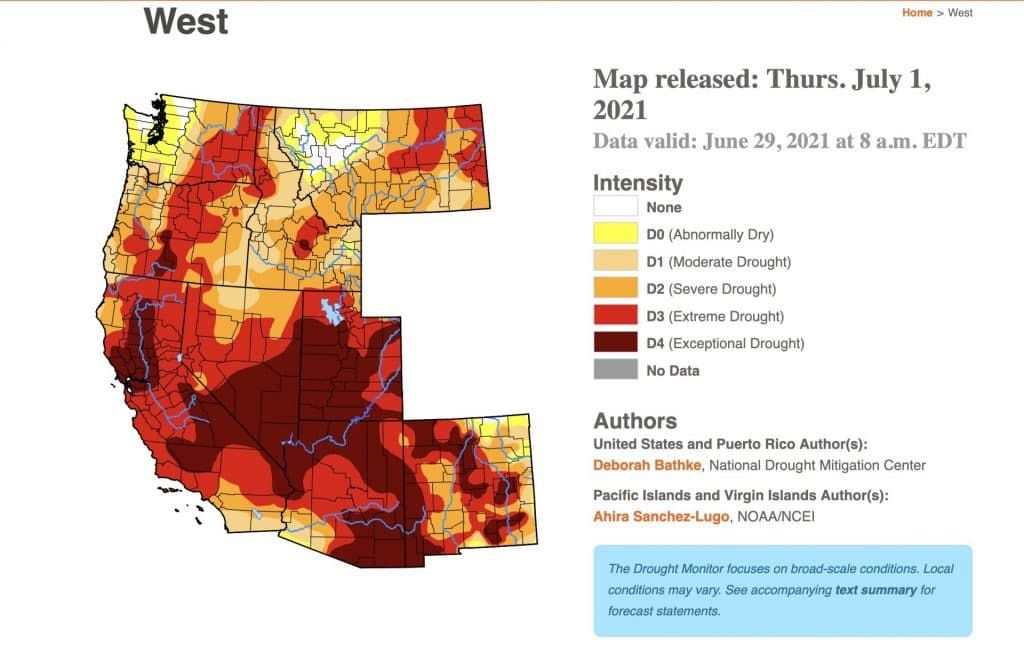Dying from the heat
By Peter Gleick | July 2, 2021
 Image courtesy of US Drought Monitor/National Drought Mitigation Center, University of Nebraska-Lincoln.
Image courtesy of US Drought Monitor/National Drought Mitigation Center, University of Nebraska-Lincoln.
No one wants to be a statistic in a climate disaster—an anonymous entry in a dataset of extreme events. But sometimes things sneak up on you. A couple of weeks ago, during one of the extraordinary and severe heat events striking western North America, I almost suffered from heat stroke.
You’d think I would know better—I’m a climate scientist and hydrologist. I’ve been researching, writing about, and discussing climate and weather risks for nearly four decades. I know that heat deaths are the most prevalent of all deaths from natural disasters, killing thousands or even tens of thousands of people every year. I know that extreme heat events are getting worse, precisely because of human-caused climate change.
And yet, there I was, trying to dig a simple hole in the ground for a wooden post in the dense, clay soils of the foothills of the Sierra Nevada in 100-degree-plus heat. Fifteen minutes was all it took for me to suddenly experience extreme dizziness and nausea. I came very close to passing out and was only saved by two nearby workers who brought me cold water and a cold compress to put on my head and neck and saw me safely back to an air-conditioned enclosure.
Climate change is already causing an increase in extreme events, including droughts and heat. The western United States is suffering from perhaps the most widespread and severe drought in recent history. As of early July, more than 98 percent of the American West was suffering from drought, with more than 80 percent in severe drought or worse. Extreme heat has struck several times since June, breaking records throughout the region and putting more than 20 million people under heat warnings from Canada to Mexico. Portland, Oregon broke a new record high of 115 degrees Fahrenheit; Seattle set a new record high of 108. Temperatures in the small town of Lytton, British Columbia, climbed to 121 degrees Fahrenheit (49.5 degrees Celsius), the highest temperature ever recorded in Canada, and then the town was destroyed by a fast-burning wildfire. Wildfires are now spreading rapidly throughout the region. Water levels in the major Colorado River reservoirs are at record lows, and Arizona and Nevada will almost certainly see reductions in their allocations from the river next year.
We’re not prepared for climate change, even in one of the wealthiest countries of the world and even with decades of warnings from scientists, in part because of extensive efforts of climate denial, the waffling of politicians, and legacy infrastructure built for yesterday’s climate, not tomorrow’s. In the Pacific Northwest, for example, struck by the recent extreme heat, very few people have air-conditioners, worsening the risk of heat illnesses among the most vulnerable populations. In a severe heat wave in Europe in 2019, several thousand people died and power plants had to be shut down because water temperatures were too high to cool them. A worse European heat wave in 2003 killed an estimated 70,000 people.
This is just the beginning. The Earth has only warmed by around a degree or two so far and is on track for several more degrees of warming. And yet the severe imbalances we’re now experiencing in extreme weather are only going to get worse with each passing year if rapid reductions in greenhouse gas emissions can’t be achieved. The heat extremes we’re seeing now will become the baseline—regular events—punctuated by even more extreme high temperatures as the planet warms further and weather patterns are increasingly disrupted.
I think I know better now than to try to do physical labor during extreme heat. But many workers have little or no ability to avoid these risks: farmworkers, construction workers, laborers of all kinds who are exposed to increasingly severe conditions and are often not informed about the risks or offered protections from them. More people are going to get sick; more are going to die from climate threats. Try not to be one of them, and do what you can to get our politicians to acknowledge and work to reduce these risks.
Together, we make the world safer.
The Bulletin elevates expert voices above the noise. But as an independent nonprofit organization, our operations depend on the support of readers like you. Help us continue to deliver quality journalism that holds leaders accountable. Your support of our work at any level is important. In return, we promise our coverage will be understandable, influential, vigilant, solution-oriented, and fair-minded. Together we can make a difference.
Keywords: climate change, climate crisis, drought, extreme events, global warming, heat wave
Topics: Climate Change, Opinion, Personal Essay















